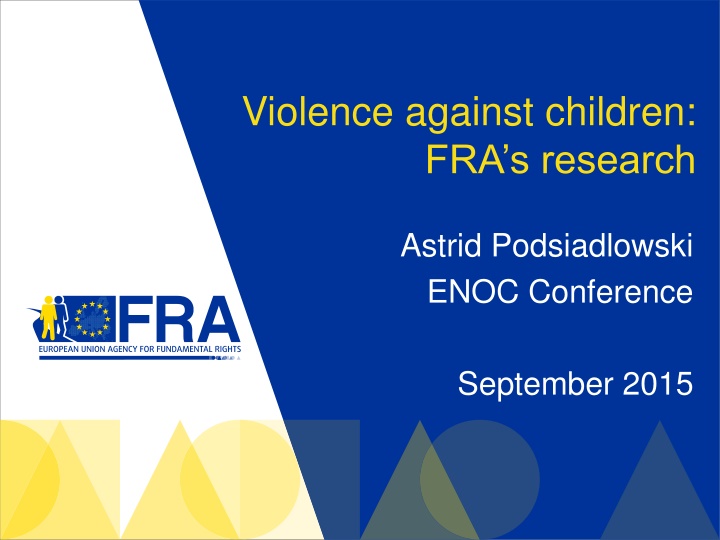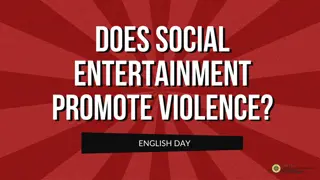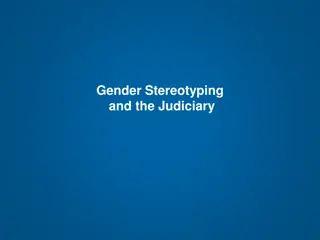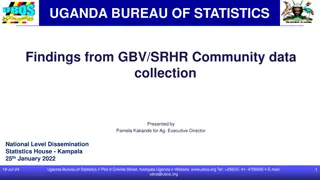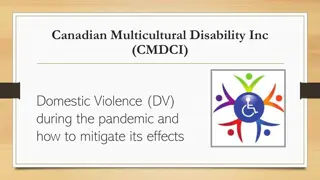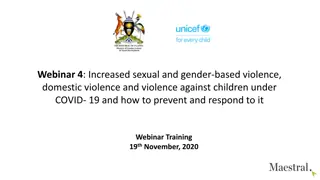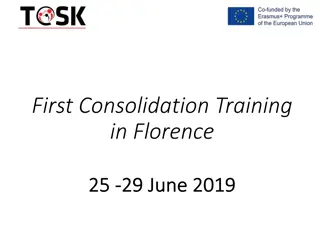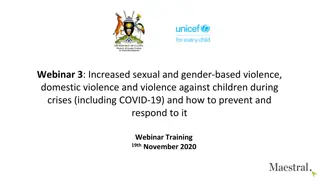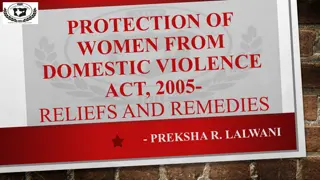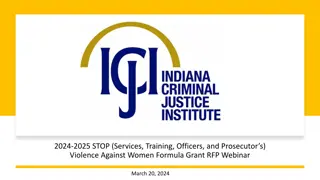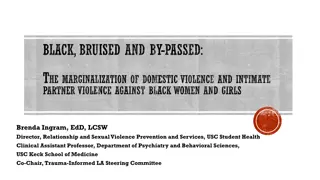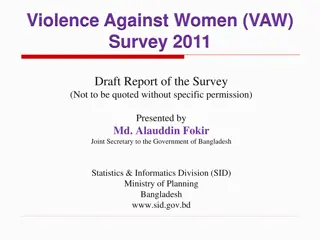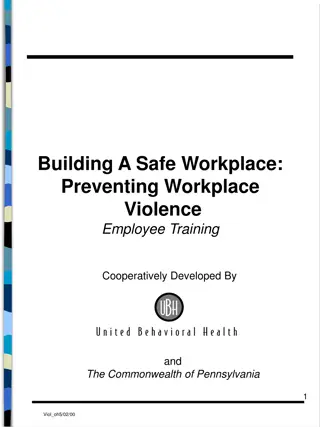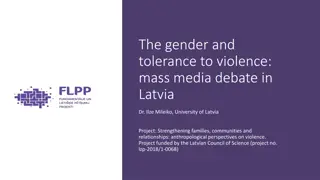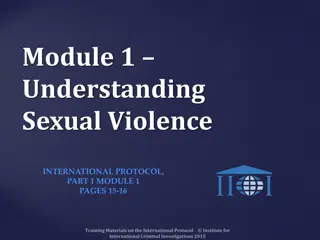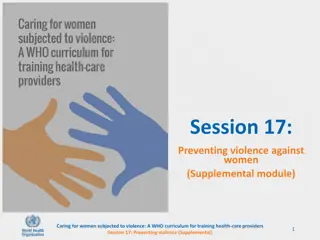Violence Against Children: FRA Research on EU Member States
FRA's role in providing evidence-based advice and assistance on fundamental rights issues, focusing on violence against children with disabilities. Survey data reveals disturbing statistics on violence against children and women. Research highlights challenges, contexts, and promising practices in addressing violence against children with disabilities in EU Member States.
Download Presentation

Please find below an Image/Link to download the presentation.
The content on the website is provided AS IS for your information and personal use only. It may not be sold, licensed, or shared on other websites without obtaining consent from the author.If you encounter any issues during the download, it is possible that the publisher has removed the file from their server.
You are allowed to download the files provided on this website for personal or commercial use, subject to the condition that they are used lawfully. All files are the property of their respective owners.
The content on the website is provided AS IS for your information and personal use only. It may not be sold, licensed, or shared on other websites without obtaining consent from the author.
E N D
Presentation Transcript
Violence against children: FRA s research Astrid Podsiadlowski ENOC Conference September 2015
Outline Brief overview of FRA and related activities Focused projects: violence against children with disabilities and treatment of children in judicial proceedings
FRAS role and tasks to provide assistance and expertise on fundamental rights issues to the European Union institutions and the Member States, when they implement EU law PROVIDING EVIDENCE-BASED ADVICE Information & data collection: research & comparative analysis INFORMATION ABOUT FRA WORK to promote dialogue with civil society, in order to raise public awareness of fundamental rights and actively disseminate information about its work AWARENESS RAISING Ref. Council Regulation (EC) 168/2007 of 15 /02/2007
Some survey data on violence against children Violence against women: 33% of women have experienced physical or sexual violence by an adult before they were 15 years old Some 12% of women have experienced some form of sexual violence by an adult before they were 15 years old. Perpetrators of physical violence were family members: father (55%), the mother (46%) LGBT: 32% of the respondents across the EU aged 18-24 has experienced physical/sexual attacks in the last 5 years 54% of them think that the most serious incident happened being L, G, B and/or T. 7% of them indicated a family member as perpetrator of the most serious incident. When under 18 years old, 78% of the respondents experienced negative comments and/or conducts about them being G, L, B and/or T.
In school: "You were told all the time that you were worthless, you re bad, stupid and all that. So I never had any friends at all. (Interview respondent) Research on Violence against children with disabilities
In school: "You were told all the time that you were worthless, you re bad, stupid and all that. So I never had any friends at all. (Interview respondent) Violence against children with disabilities: overview What? Violence against children with disabilities legal and policy framework Extent, triggers, forms and contexts challenges and promising practices Why? Previous evidence. Under-researched area falling between the gaps How? Desk research on laws and policies in 28 EU Member States 132 interviews with stakeholders in 13 EU Member States (AT, BG, CZ, DK, HR, IT, LT, NL, PL, PT, SE, SI and UK)
Various approaches to legal and policy coverage National legal and policy frameworks Law: Right of the child to be free from violence Disability and age as aggravating circumstances Obligation to report Policies: weak coverage and few practical tools National policies on child rights or disability Violence in particular settings Weak monitoring We have almost stopped saying that we want more legislation. We actually just want the existing legislation to be respected (Interview respondent) Implementation a challenge
Extent of violence against children with disabilities More vulnerable to violence than children without disabilities Children with invisible disabilities at higher risk Children with multiple and severe impairments, and children who communicate in a non-traditional way are particularly vulnerable The degree of disability is a deciding factor, who suffers from a serious or a severe disability, s/he will never report any abuse (Interview respondent)
Increased dependency Easy targets Lack of knowledge about disability Over- burdening of parents Respondents views on Triggers of violence Overextended and untrained care personnel Prejudice and fear of otherness
Intersection with other characteristics Poverty and socio-economic background Lack of financial support Link to poverty Unfortunately there is more and more evidence that children are being bullied because of poverty. Poverty compounds these issues for children with disability. (Interview respondent) Ethnicity Roma children especially vulnerable Taboo and shame associated with disability Gender Girls at risk of sexual violence
Promising practices Ireland- Children First: National Guidance for the Protection and Welfare of Children Finland- Don t hit the child action plan on combating corporal punishment Croatia- Step by step - empowering children with intellectual disabilities
Key recommendations: 10 points 1. 2. Establishing inclusive child protection systems Enhancing the legal and political framework for protection of children with disabilities Ensuring coordination and appointing a focal point on children with disabilities Addressing societal attitudes and countering isolation Promoting child-focused prevention measures and child participation Providing family-focused services Ensuring inclusive education and participation in all aspects of life on equal basis with others Advancing de-institutionalisation efforts and strengthening the monitoring of institutions Developing tools, allocating adequate resources and improving human resource capacity 10. Collecting data 3. 4. 5. 6. 7. 8. 9.
I had an opportunity to talk, I have been heard, my wishes have been taken into account, although not as seriously as they could have been. (14 year old girl in multiple proceedings) Research on Children and Justice
Judicial proceedings How are children involved and treated The protection of the rights of children is an EU objective. The Treaty of Lisbon emphasises the promotion of child rights. EU Agenda for the Rights of the Child identified lack of official data In 9 EU MSs, where data is available, around 74,000 children were victims of crime in 2010. How do judicial procedures respond to children s needs? EC (EU) legal and policy provisions, statistical information FRA (10 MSs) evidence on how legal and policy provisions are applied on the ground to address children s needs, when they are involved as witnesses, victims and parties to criminal and civil proceedings
FRA research on child-friendly justice Assessing How are children s needs and rights addressed in judicial proceedings How are the CoE s Guidelines on child-friendly justice applied Through Personal interviews, focus groups and consultations with 570 professionals 360 children EU Member States covered BG DE EE ES FI FR HR PL RO UK
General findings There is great variation of actual practices not only across Member States but also within. This often depends on the judgement of the individual professional. Concrete measures on a child s right to be informed, to be heard and to be protected are not standard practice. A lot more needs to be done to make justice more child-friendly so that children feel safe and comfortable to be able to express their views freely and participate effectively.
Childs right to information - challenges Lack of clear and specific provisions and guidelines on how to inform children what to tell them regarding the proceedings/ their rights when and who should inform them In many cases practices are not appropriate Information is often minimal and not understandable Responsibility often unclear and/or left to parents Information material rarely child-friendly and adapted
In Bulgaria a simple drawing helps children understand courts In France Avoc enfants helps children find a lawyer and get advice
Childs right to information what could be done Clear guidelines on how children should be informed Clear responsibility: who provides this information Social - psychological support and guidance Well informed children are more likely to provide good evidence that is taken into account by police and courts Professionals suggest one contact point/support person who is responsible for informing children (and their parents) throughout the proceedings
Childs right to be heard - challenges usually the child is already overcoming the situation and trauma, time has passed, and then the case gets finally to court and it all starts over again Victim Support officer in Estonia Length of proceedings and number of hearings Inappropriate ways of questioning children Hearing environments not child-friendly
In Poland, blue rooms create safe spaces to host hearings In Estonia, dolls are used to facilitate child hearings
Childs right to be heard what could be done Clear guidelines on how children should be interviewed Technical provisions as safeguards Examples: Child-friendly interview rooms & material Video and/or video-links to avoid facing people that can re-traumatise Familiarisation with court and judge before starting formal proceedings Simplify judges appearance, e.g. avoid formal wigs and/or gowns Co-operation between professionals to avoid repetitions and confusion When children feel safe they can contribute better to the process
For more information or publications www.fra.europa.eu or contact us childrights@fra.europa.eu 25
